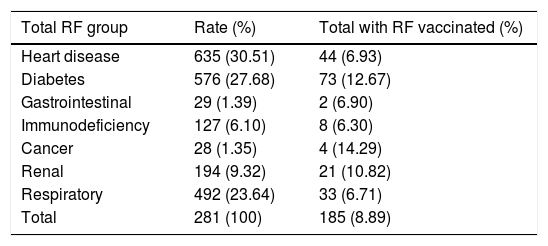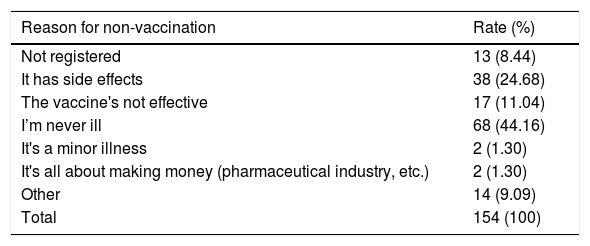To determine the effectiveness of the brief intervention for influenza vaccination (VAG) to increase coverage in risk groups.
DesignPilot, quasi-experimental study.
LocationUrban Primary Care Team (EAP) of Manresa.
ParticipantsThe study population was the users assigned and cared for during 2016 by the EAP, and included in the risk groups for the VAG. The intervention group, with prior informed consent, consisted of 157 users with indication of VAG attended by their reference team during the vaccination campaign, andwho had initially refused to be vaccinated. As a control group, 3338 users were selected with indication of unvaccinated VAG in the previous three years.
Intervention Short advice (CB) standardised and adapted to the reasons expressed by the patient to refuse vaccination.
Main measurementsReasons for VAG rejection and flu vaccination coverage were studied in the control and intervention groups, according to age and risk groups. The analysis was performed using the Chi-squared test for independent samples.
ResultsThe most frequent reasons for not being vaccinated were «never ill» (44.16%) and «the vaccine has side effects» (24.68%). The intervention was effective (OR: 2.1 [1.35-3.29]; p=.002).
ConclusionsThe brief advice for flu vaccination coverage proved to be an effective method to increase vaccination, and easily applicable in primary care.
Determinar la efectividad del consejo breve (CB) para la vacunación antigripal (VAG) con objeto de aumentar la cobertura en los grupos de riesgo
DiseñoEstudio piloto, cuasi-experimental.
EmplazamientoEquipo de atención primaria (EAP) urbano de Manresa.
ParticipantesLa población de estudio fueron los usuarios asignados y atendidos durante el año 2016 en el EAP, incluidos en los grupos de riesgo para la VAG. Se seleccionaron para la intervención, previo consentimiento informado, 157 usuarios con indicación de VAG atendidos por su equipo de referencia durante la campaña de vacunación, que inicialmente habían rehusado ser vacunados. Como grupo control se seleccionaron 3.338 usuarios con indicación de VAG no vacunados en los 3 años anteriores. Intervención: El CB estandarizado y adaptado a los motivos que el paciente expresó para rechazar la vacunación.
Mediciones principalesSe estudiaron los motivos de rechazo de la VAG y la cobertura vacunal de la gripe en los grupos control e intervención, según edad y grupos de riesgo. El análisis se realizó mediante la prueba de Chi-cuadrado para muestras independientes.
ResultadosLos motivos más frecuentes para no vacunarse fueron «no enfermo nunca» (44,16%) y «la vacuna tiene efectos secundarios» (24,68%). La intervención fue efectiva (OR: 2,1 [1,35-3,29]; p=0,002).
ConclusionesEl CB para la VAG demostró ser un método efectivo para aumentar la vacunación, fácilmente aplicable en atención primaria.










